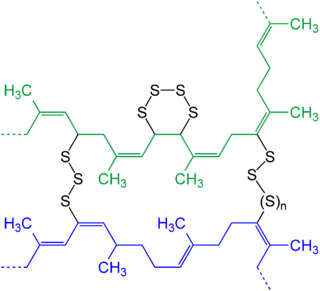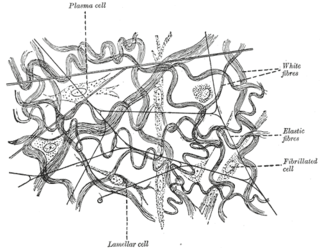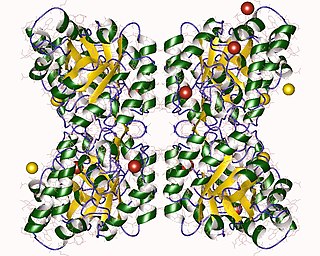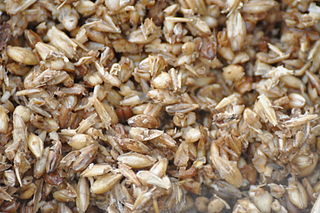
Lysine (symbol Lys or K) is an α-amino acid that is a precursor to many proteins. It contains an α-amino group (which is in the protonated −NH+
3 form under biological conditions), an α-carboxylic acid group (which is in the deprotonated −COO− form under biological conditions), and a side chain lysyl ((CH2)4NH2), classifying it as a basic, charged (at physiological pH), aliphatic amino acid. It is encoded by the codons AAA and AAG. Like almost all other amino acids, the α-carbon is chiral and lysine may refer to either enantiomer or a racemic mixture of both. For the purpose of this article, lysine will refer to the biologically active enantiomer L-lysine, where the α-carbon is in the S configuration.

Elastin is a protein that in humans is encoded by the ELN gene. Elastin is a key component of the extracellular matrix in gnathostomes. It is highly elastic and present in connective tissue allowing many tissues in the body to resume their shape after stretching or contracting. Elastin helps skin to return to its original position when it is poked or pinched. Elastin is also an important load-bearing tissue in the bodies of vertebrates and used in places where mechanical energy is required to be stored.

In chemistry and biology a cross-link is a bond or a short sequence of bonds that links one polymer chain to another. These links may take the form of covalent bonds or ionic bonds and the polymers can be either synthetic polymers or natural polymers.

Elastic fibers are an essential component of the extracellular matrix composed of bundles of proteins (elastin) which are produced by a number of different cell types including fibroblasts, endothelial, smooth muscle, and airway epithelial cells. These fibers are able to stretch many times their length, and snap back to their original length when relaxed without loss of energy. Elastic fibers include elastin, elaunin and oxytalan.

The Royal Society Te Apārangi is an independent, statutory not-for-profit body in New Zealand providing funding and policy advice in the fields of sciences and the humanities.

Allysine is a derivative of lysine, used in the production of elastin and collagen. It is produced by the actions of the enzyme lysyl oxidase in the extracellular matrix and is essential in the crosslink formation that stabilizes collagen and elastin.

Oleuropein is a glycosylated seco-iridoid, a type of phenolic bitter compound found in green olive skin, flesh, seeds, and leaves. The term oleuropein is derived from the botanical name of the olive tree, Olea europaea.

Sir Peter David Gluckman is a New Zealand scientist. Originally trained as a paediatrician, he served as the inaugural Chief Science Advisor to the New Zealand Prime Minister from 2009 to 2018. He is a founding member and was inaugural chair of the International Network for Government Science Advice, and is president of the International Science Council.
The Marsden Medal is a yearly award given by the New Zealand Association of Scientists. It is named after Sir Ernest Marsden and honours "a lifetime of outstanding service to the cause or profession of science, in recognition of service rendered to the cause or profession of science in the widest connotation of the phrase." It rivals the Rutherford Medal from the Royal Society of New Zealand.

Christine Coe Winterbourn is Professor of Pathology at the University of Otago, in New Zealand.

Dame Margaret Anne Brimble is a New Zealand chemist. Her research has included investigations of shellfish toxins and means to treat brain injuries.

4-Hydroxy-tetrahydrodipicolinate synthase (EC 4.3.3.7, dihydrodipicolinate synthase, dihydropicolinate synthetase, dihydrodipicolinic acid synthase, L-aspartate-4-semialdehyde hydro-lyase (adding pyruvate and cyclizing), dapA (gene)) is an enzyme with the systematic name L-aspartate-4-semialdehyde hydro-lyase (adding pyruvate and cyclizing; (4S)-4-hydroxy-2,3,4,5-tetrahydro-(2S)-dipicolinate-forming). This enzyme catalyses the following chemical reaction

Shirley Yeta Horrocks is a New Zealand documentary filmmaker, specialising in social and art topics. She was appointed an Officer of the New Zealand Order of Merit, for services to documentary filmmaking, in the 2019 New Year Honours. The citation notes that "Horrocks is a leader in documentary films on the arts in New Zealand and has directed and produced documentaries for 35 years".

Hemp protein is a plant-derived protein from the cannabis plant and is isolated from hemp seeds. The protein in hemp seeds is made up of the two highly digestible globular types of proteins, edestin (60–80%) and 2S albumin, with edestin also being rich in the essential amino acids.

Miriam Cather Simpson is a New Zealand-American physics/chemistry academic and entrepreneur. She is currently a professor at the University of Auckland, a joint appointment between the physics and chemistry departments. She is the founder of the Photon Factory laser lab at the University of Auckland and the chief science officer for two spin-off companies, Engender Technologies and Orbis Diagnostics. She is an Associate Investigator for the Dodd-Walls Centre for Photonic and Quantum Technologies and an Emeritus Investigator for the MacDiarmid Institute for Advanced Materials and Nanotechnology. She was awarded the Royal Society Te Apārangi Pickering Medal in 2019. She has a strong focus on teaching, mentoring and public outreach and is an outspoken advocate for issues of gender equality and ethics in science.
Deborah Lucy Hay is a New Zealand academic. In 2022 she was elected a Fellow of the Royal Society Te Apārangi.
Joanna Jean Putterill is a New Zealand molecular botanist. She is currently a full professor at the University of Auckland.

Heather D. Maynard is the Dr Myung Ki Hong Professor in Polymer Science at the University of California, Los Angeles. She works on protein-polymer conjugates and polymeric drugs. Maynard is a Fellow of the Royal Society of Chemistry and the American Association for the Advancement of Science.

Brewer's spent grain (BSG) or draff is a food waste that is a byproduct of the brewing industry that makes up 85 percent of brewing waste. BSG is obtained as a mostly solid residue after wort production in the brewing process. The product is initially wet, with a short shelf-life, but can be dried and processed in various ways to preserve it.
Suzanne Georgina Pitama is a New Zealand academic, is Māori, of Ngāti Kahungunu and Ngāti Whare descent and as of 2020 is a full professor at the University of Otago in Christchurch, New Zealand.
















